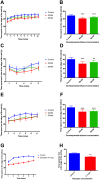Sustained Effects of Developmental Exposure to Ethanol on Zebrafish Anxiety-Like Behaviour
- PMID: 26862749
- PMCID: PMC4749633
- DOI: 10.1371/journal.pone.0148425
Sustained Effects of Developmental Exposure to Ethanol on Zebrafish Anxiety-Like Behaviour
Abstract
In zebrafish developmentally exposed to ambient ethanol (20mM-50mM) 1-9 days post fertilization (dpf), the cortisol response to stress has been shown to be significantly attenuated in larvae, juveniles and 6 month old adults. These data are somewhat at variance with similar studies in mammals, which often show heightened stress responses. To test whether these cortisol data correlate with behavioural changes in treated animals, anxiety-like behaviour of zebrafish larvae (9dpf and 10dpf) and juveniles (23dpf) was tested in locomotor assays designed to this end. In open field tests treated animals were more exploratory, spending significantly less time at the periphery of the arena. Behavioural effects of developmental exposure to ethanol were sustained in 6-month-old adults, as judged by assessment of thigmotaxis, novel tank diving and scototaxis. Like larvae and juveniles, developmentally treated adults were generally more exploratory, and spent less time at the periphery of the arena in thigmotaxis tests, less time at the bottom of the tank in the novel tank diving tests, and less time in the dark area in scototaxis tests. The conclusion that ethanol-exposed animals showed less anxiety-like behaviour was validated by comparison with the effects of diazepam treatment, which in thigmotaxis and novel tank diving tests had similar effects to ethanol pretreatment. There is thus a possible link between the hypophyseal-pituitary-interrenal axis and the behavioural actions of developmental ethanol exposure. The mechanisms require further elucidation.
Conflict of interest statement
Figures




References
-
- Colangelo W, Jones DG (1982) The fetal alcohol syndrome: a review and assessment of the syndrome and its neurological sequelae. Prog Neurobiol 19: 271–314. - PubMed
-
- Jones KL, Smith DW (1973) Recognition of the fetal alcohol syndrome in early infancy. Lancet 302: 999–1001. - PubMed
-
- Evrard SG (2010) Prenatal alcohol exposure as an etiological factor in neuropsychiatric diseases of childhood, adolescence and adulthood. Vertex 21: 260–265. - PubMed
Publication types
MeSH terms
Substances
Grants and funding
LinkOut - more resources
Full Text Sources
Other Literature Sources
Medical
Molecular Biology Databases

